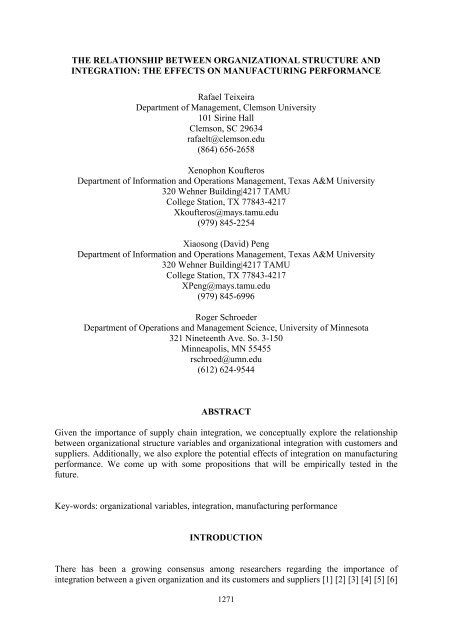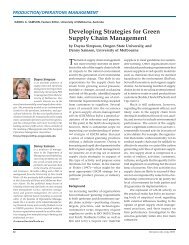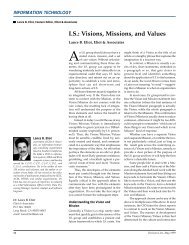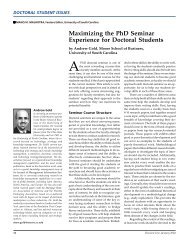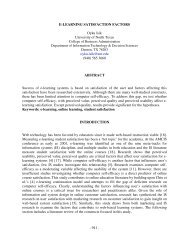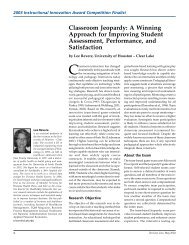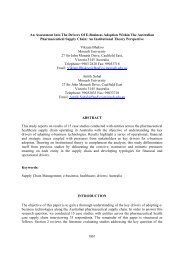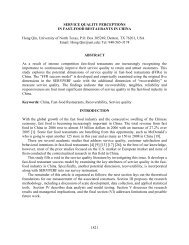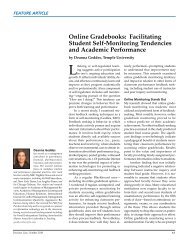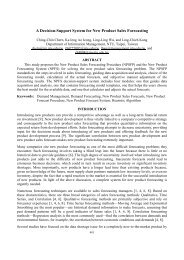The Relationship Between Organizational Structure and Integration
The Relationship Between Organizational Structure and Integration
The Relationship Between Organizational Structure and Integration
Create successful ePaper yourself
Turn your PDF publications into a flip-book with our unique Google optimized e-Paper software.
THE RELATIONSHIP BETWEEN ORGANIZATIONAL STRUCTURE AND<br />
INTEGRATION: THE EFFECTS ON MANUFACTURING PERFORMANCE<br />
Rafael Teixeira<br />
Department of Management, Clemson University<br />
101 Sirine Hall<br />
Clemson, SC 29634<br />
rafaelt@clemson.edu<br />
(864) 656-2658<br />
Xenophon Koufteros<br />
Department of Information <strong>and</strong> Operations Management, Texas A&M University<br />
320 Wehner Building|4217 TAMU<br />
College Station, TX 77843-4217<br />
Xkoufteros@mays.tamu.edu<br />
(979) 845-2254<br />
Xiaosong (David) Peng<br />
Department of Information <strong>and</strong> Operations Management, Texas A&M University<br />
320 Wehner Building|4217 TAMU<br />
College Station, TX 77843-4217<br />
XPeng@mays.tamu.edu<br />
(979) 845-6996<br />
Roger Schroeder<br />
Department of Operations <strong>and</strong> Management Science, University of Minnesota<br />
321 Nineteenth Ave. So. 3-150<br />
Minneapolis, MN 55455<br />
rschroed@umn.edu<br />
(612) 624-9544<br />
ABSTRACT<br />
Given the importance of supply chain integration, we conceptually explore the relationship<br />
between organizational structure variables <strong>and</strong> organizational integration with customers <strong>and</strong><br />
suppliers. Additionally, we also explore the potential effects of integration on manufacturing<br />
performance. We come up with some propositions that will be empirically tested in the<br />
future.<br />
Key-words: organizational variables, integration, manufacturing performance<br />
INTRODUCTION<br />
<strong>The</strong>re has been a growing consensus among researchers regarding the importance of<br />
integration between a given organization <strong>and</strong> its customers <strong>and</strong> suppliers [1] [2] [3] [4] [5] [6]<br />
1271
[7]. However, very few studies explore the antecedents of supply chain integration. We<br />
attempt to fill this gap in literature by exploring how organizational structure may enhance<br />
supply chain integration since organizational structure is recognized for influencing<br />
organizational behavior. More specifically, we explored how the level of centralization,<br />
flatness, <strong>and</strong> horizontal integration influences the organizational integration <strong>and</strong> the effects of<br />
supply chain integration on manufacturing performance outcomes. We conceptualized supply<br />
chain integration as three distinct variables: internal integration, supplier integration, <strong>and</strong><br />
customer integration.<br />
LITERATURE REVIEW AND THEORY DEVELOPMENT<br />
<strong>The</strong> theoretical model of the relationship between organizational structure, internal<br />
communication, integration, <strong>and</strong> performance is presented in Figure 1. In our theoretical<br />
model, integration is a broader construct composed by three parts: supplier integration,<br />
customer integration, <strong>and</strong> functional integration.<br />
FIGURE 1<br />
<strong>The</strong> proposed theoretical framework<br />
<strong>Organizational</strong><br />
<strong>Structure</strong><br />
<strong>Organizational</strong><br />
<strong>Integration</strong><br />
Manufacturing<br />
Performance<br />
Quality<br />
Centralization<br />
Internal<br />
<strong>Integration</strong><br />
Flexibility<br />
Flatness<br />
Managerial<br />
specialization<br />
Employee<br />
specialization<br />
Internal<br />
Communication<br />
Supplier<br />
<strong>Integration</strong><br />
Customer<br />
<strong>Integration</strong><br />
Cost<br />
Delivery<br />
Innovation<br />
<strong>Organizational</strong> <strong>Structure</strong><br />
<strong>Organizational</strong> structure is the way responsibility <strong>and</strong> power are allocated, <strong>and</strong> work<br />
procedures are carried out among organizational members [8] [9] [10] [11] [12] [13]. Among<br />
many variables, organizational structure includes the nature of layers of hierarchy,<br />
centralization of authority, <strong>and</strong> horizontal integration.<br />
1272
Centralization is one of the organizational structure dimensions influencing the degree of<br />
communication <strong>and</strong> can be defined as the degree to which the right to make decisions <strong>and</strong><br />
evaluate activities is concentrated [14] [15]. Flatness of an organization is conceptualized as<br />
the degree to which an organization has many or few levels of management hierarchy [13]<br />
[16]. A flat organization can reduce problems of information delays, distortion <strong>and</strong> corruption<br />
as information is passed from one level to another because of the fewer levels of hierarchy<br />
compared to the number of hierarchical levels in other type of organizations. Specialization<br />
of department <strong>and</strong> employees refers to the level of horizontal integration within an<br />
organization, that is, is the degree to which departments <strong>and</strong> employees are functionally<br />
specialized or integrated. Low levels of horizontal integration reflects an organization in<br />
which the departments <strong>and</strong> employees are functionally specialized, whereas high levels of<br />
horizontal integration reflects an organization in which the departments <strong>and</strong> employees are<br />
integrated in their work, skills, <strong>and</strong> training [11] [17] [18] [19].<br />
Internal Communication<br />
Communication is viewed as a transmission process trough a channel (mode) that includes<br />
messages (content), the channel (mode), feedback (bidirectional communication), <strong>and</strong><br />
communication effects [20]. Conceptualizing communication inside organizations, Gruning<br />
et al. [21, p.486] define internal communication as a “specialized sub-discipline of<br />
communication that examines how people communicate in organizations <strong>and</strong> the nature of<br />
effective communication systems in organizations”. For other authors [13] [22], the level of<br />
communication can be conceptualized as the degree to which vertical <strong>and</strong> horizontal<br />
communication is slow, difficult, <strong>and</strong> limited versus fast, easy, <strong>and</strong> abundant.<br />
<strong>Integration</strong><br />
According to Lawrence <strong>and</strong> Lorch [23, p.1], integration is “the quality or state of<br />
collaborations that exists among departments that are required to achieve unity of effort by<br />
the dem<strong>and</strong>s of the environment”. Recent studies in the context of the supply chain<br />
management, however, have proposed a broader concept of integration that includes not only<br />
integration of buyers, but also integration of suppliers in the chain [24] [25] [26] [27]. For the<br />
purpose of this research, we define integration as the collaboration <strong>and</strong> linkages between <strong>and</strong><br />
across organizational functions as well as organizational partners, including customers <strong>and</strong><br />
suppliers.<br />
Internal integration refers to the cross-functional team orientation reflecting the linkages<br />
within organizational functions <strong>and</strong> teams, also known as horizontal linkages [29] [29] [30].<br />
High degree of cross-functional integration implies a richness collaboration <strong>and</strong><br />
communication among people <strong>and</strong> departments, increasing mutual feedback <strong>and</strong> the ability to<br />
solve problems. Supplier integration refers to the collaborative involvement of suppliers with<br />
an organization, providing operational [31] as well as strategic [32] information <strong>and</strong><br />
supporting activities such as new product development processes [33]. Because of its<br />
1273
strategic nature, supplier integration can be characterized by the collaborative <strong>and</strong> long-term<br />
relationship between buyer <strong>and</strong> supplier [34], involving high levels of trust, commitment <strong>and</strong><br />
information sharing [35] [36]. Customer integration is defined as the collaborative<br />
involvement of customers within an organization, strategically sharing information <strong>and</strong><br />
knowledge about their needs <strong>and</strong> organization’s product performance such as quality,<br />
delivery time, <strong>and</strong> cost. Close <strong>and</strong> collaborative relationships with customers may be one<br />
important factor influencing supply chain performance [37], market performance [27], <strong>and</strong><br />
innovation [38] [39].<br />
<strong>The</strong> <strong>Relationship</strong> between <strong>Organizational</strong> <strong>Structure</strong> Variables <strong>and</strong> Internal<br />
Communication<br />
<strong>Organizational</strong> structure is recognized by many authors to have effects on the level of internal<br />
communication [14] [40] [41] [42]. <strong>The</strong> flow of information <strong>and</strong> intensity of communication<br />
as well as horizontal <strong>and</strong> vertical integration depends on, among other structural variables,<br />
the level of centralization, flatness, <strong>and</strong> horizontal integration. A structure can stimulate or<br />
inhibit the flow of communication by developing mechanisms to encourage participation <strong>and</strong><br />
information sharing. Hage, Aiken, <strong>and</strong> Marrett [43] found that in less complex, less formal,<br />
<strong>and</strong> decentralized organization, communication was greater than in complex, formal, <strong>and</strong><br />
centralized organizations. Thus, vertical communication is highly developed in flatness<br />
organizations when compared to organization with high number of hierarchy levels. Because<br />
of an increase in the knowledge sharing <strong>and</strong> training of employees, high levels of horizontal<br />
integration tends to increase the level of internal communication [19] [44]. Specialized<br />
employees are more likely to share their ideas in a high horizontally integrated organization<br />
than in an organization with low horizontally integrated organization. <strong>The</strong>refore, we<br />
hypothesize that:<br />
Proposition 1a: Centralization is negatively related to internal communication.<br />
Proposition 1b: Flatness is positively related to internal communication.<br />
Proposition 1c: Horizontal integration is positively related to internal communication.<br />
<strong>The</strong> <strong>Relationship</strong> between Internal Communication <strong>and</strong> <strong>Organizational</strong> <strong>Integration</strong><br />
Internal communication is assumed to enhance internal <strong>and</strong> external organizational<br />
integration because it increases the interaction <strong>and</strong> flow of information between employees,<br />
allowing them to improve coordination of activities. Because of the richness communication<br />
between cross-functional teams, departments <strong>and</strong> function in organizations develop closely<br />
relationships <strong>and</strong> collaborative behaviors. Empirical studies have found positive effects of<br />
internal communication on a variety of outcomes, including inter-functional integration [45],<br />
underst<strong>and</strong>ing <strong>and</strong> harmony between functions [46], coordination [47], <strong>and</strong> market<br />
orientation [48]. Research on supplier integration is also based on the assumption of internal<br />
communication as a way to properly make use of suppliers’ knowledge <strong>and</strong> achieve superior<br />
performance [25] [27] [49]. In conceptualizing about customer integration competence, Jacob<br />
[50] demonstrated that communication was one important competence organizations must<br />
possess in order to successfully integrate with their customers. Thus, we hypothesize:<br />
Proposition 2a: Internal communication is positively related to internal integration.<br />
Proposition 2b: Internal communication is positively related to supplier integration.<br />
1274
Proposition 2c: Internal communication is positively related to customer integration.<br />
<strong>The</strong> <strong>Relationship</strong> between <strong>Organizational</strong> <strong>Integration</strong> <strong>and</strong> Manufacturing Performance<br />
Literature has strongly suggested the relationship between organizational integration <strong>and</strong><br />
firms’ performance outcomes [24] [25] [26] [27] [33] [38] [49] [51] [52] [53] [54] [55] [56]<br />
[57]. Organizations with high levels of internal <strong>and</strong> external integration are more likely to<br />
regularly examine their performance compared to other competitors as well as identify<br />
customers’ needs more quickly. Internal integration reduces uncertainty by improving<br />
communication between departments. Cross-functional teams composed by specialized<br />
employees with different background <strong>and</strong> knowledge can share information <strong>and</strong> improve the<br />
decision making process. Because of the early involvement of participants, this enriched<br />
decision making process helps to clarify product requirements before too much money has<br />
been invested [58]. Information sharing <strong>and</strong> technology helps teams to develop better product<br />
<strong>and</strong> new features, enhancing product performance [59]. Thus, we hypothesize:<br />
Proposition 3a: Internal integration is positively related to product innovation performance.<br />
Proposition 3b: Internal integration is positively related to quality performance.<br />
Proposition 3c: Internal integration is positively related to delivery time performance.<br />
Proposition 3d: Internal integration is positively related to flexibility performance.<br />
Proposition 3e: Internal integration is positively related to cost performance.<br />
Because supplier operates as strategic collaborators, supplier integration stimulates the longterm<br />
commitment <strong>and</strong> collaboration <strong>and</strong> enhances information sharing <strong>and</strong> trust. Under these<br />
circumstances, suppliers can provide information feedback about materials, pricing, <strong>and</strong><br />
process capabilities for improvement of quality, as recently demonstrated by empirical<br />
studies (Koufteros et al., 2005, 2007b; Rosenzweig et al., 2003; Swink et al. 2007).<br />
Suppliers’ involvement in early stages of new product development can also shorten <strong>and</strong><br />
speed it up (Clark, 1989, Tessarolo, 2007). Moreover, the benefits of external integration can<br />
be exemplified through the work of Rosenzweig et al. (2003). <strong>The</strong> authors demonstrated the<br />
positive effects of suppliers <strong>and</strong> customer integration on product quality, delivery reliability,<br />
process flexibility, <strong>and</strong> cost. Other example is the work of Vickery et al. (2003) that showed<br />
that external integration leads to a better customer service performance, measured in terms of<br />
pre-sale customer service, product support, responsiveness, delivery speed, <strong>and</strong> delivery<br />
dependability. <strong>The</strong>refore, we hypothesize:<br />
Proposition 4a: Supplier integration is positively related to product innovation performance.<br />
Proposition 4b: Supplier integration is positively related to quality performance.<br />
Proposition 4c: Supplier integration is positively related to delivery time performance.<br />
Proposition 4d: Supplier integration is positively related to flexibility performance.<br />
Proposition 4e: Supplier integration is positively related to cost performance.<br />
Similarly, because customer are perceived as strategic collaborators, customer integration<br />
results in many benefits for organizations because customers can provide valuable<br />
information such as their needs as well as organizations’ product performance. <strong>The</strong><br />
evaluation of products <strong>and</strong> the feedback provided by customers reduces uncertainty <strong>and</strong> helps<br />
organizations to develop better quality products [60]. Such information is fundamental for<br />
new product development that meets customer expectation [38]. Stank et al. [37] found<br />
1275
positive relationship between customer integration <strong>and</strong> many firm performance variables,<br />
including delivery speed, responsiveness, <strong>and</strong> flexibility. <strong>The</strong>y concluded that “customer<br />
integration is the most critical competency associated with improved performance” [37,<br />
p.39]. Other authors also found positive impact of customer integration on firm performance<br />
outcomes [24] [27]. However, there is little evidence on customer integration effects on<br />
quality. For example, Koufteros et al. [38] <strong>and</strong> Swink et al. [27] did not find statistically<br />
significant relationship between customer integration <strong>and</strong> quality. We, therefore, hypothesize:<br />
Proposition 5a: Customer integration is positively related to product innovation performance.<br />
Proposition 5b: Customer integration is positively related to delivery time performance.<br />
Proposition 5c: Customer integration is positively related to flexibility performance.<br />
CONCLUSION<br />
Because of the growing importance of supply chain integration <strong>and</strong> because the lack of<br />
studies exploring the factors affecting the organizational integration with customers <strong>and</strong><br />
suppliers, we develop a conceptual model to underst<strong>and</strong> how organizational structure<br />
variables may be related to internal <strong>and</strong> external integration. We also explore how such<br />
organizational integration may affect manufacturing performance. Based on management<br />
literature on organizational theory <strong>and</strong> operations literature on manufacturing <strong>and</strong> supply<br />
chain, we presented some propositions that will be empirically tested.<br />
REFERENCES<br />
Because of the large number of references <strong>and</strong> because of page limitation existent for format<br />
of this paper:<br />
- References are available upon request from Rafael Teixeira via email: rafaelt@clemson.edu.<br />
1276


